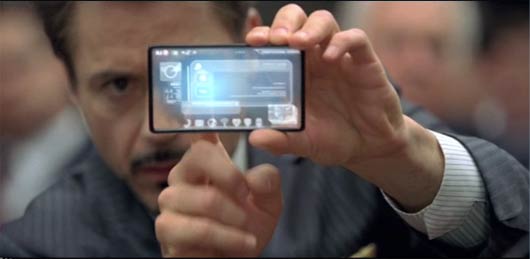For this Friday, a selection of links from around the studio about screens-in-the-world.
This video is the output of the TAT Open Innovation project – an exploration of the future of screen technology. Of course, more than ever, “screen” is becoming interchangeable with “device”, as this video explores the actions and interactions made possible by new kinds of device, both mobile and static.
And here’s Freescale Semiconductor’s vision of a screen-driven future. Smart mirrors and see-through tablets are increasingly popular tropes of the future right now.


Two more examples of transparent screens – one portable, one embedded in the environment – from Perception’s work on the visual effects for Iron Man 2. Such tropes aren’t just limited to concept videos; they’re also a part of popular culture.
Chris O’Shea’s Hand From Above makes a playful use of giant, public screens. These screens are so often passive, broadcasting devices. It’s strange and jarring – in an exciting way – to see them interacting with us. It’s like they can see.
Keiichi Matsuda’s Domestic Robocop envisages an augmented-reality future where the augmentation outweighs the reality. Practically every surface in Matsuda’s imagined kitchen has the capacity to become a screen – most of which end up displaying advertising, generating income for the homeowner.
There’s an overlap I’m beginning to see here: between “screens everywhere“, and “everything being a screen” and what we’re currently calling augmented reality. Thinking on that, I can’t help but return to this lovely video from our friend and collaborator Timo Arnall. It doesn’t matter how the map appears on the street. For the woman on the bench, the ground in front of her is the most sensible place for the map to appear. Large pieces of information can make good use of large spaces. Why not, then, make the “screen” as big as possible, and use the environment itself?
3 Comments and Trackbacks
1. Matt said on 24 September 2010...
Some great stuff here – Thanks, Tom!
Interesting though that when designers set to work on the future of screens they fill those screen with UIs designed by, erm, themselves.
Far more interesting is the potential for any screen to be subverted by the user far from its original purpose – for any screen to run anything on the Internet.
The running joke in 80s sitcom ‘Open All Hours’ was that David Jason’s character was always catching his fingers in the till. In a 2010 remake he’d be using it to check his Facebook.
2. Matt said on 24 September 2010...
Cinimod Studio did an artwork called ‘Flutter’ recently about butterflies that had 100 screens mounted in row being controlled live by the viewer. See a video on their site: http://www.cinimodstudio.com/flutter
3. Erik said on 1 October 2010...
The last version seems to be the most sensible, skip the device and project the “screen” instead.
Vernor Vinge explores this quite well in “Rainbow’s End”. Wearable computers, that wearer connects to through gestures and lenses.
Congratulations on the stellar work you are doing lately, fantastic stuff!
Erik